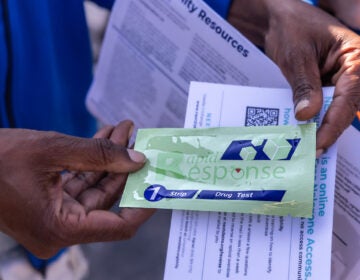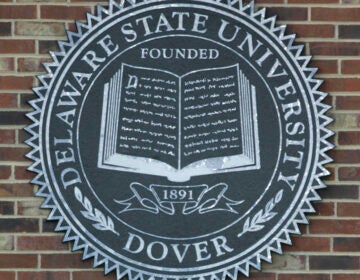Meeting the mighty ships of the Delaware Bay — just another day at the office [video]
While our Cost to the Coast series has focused on rising seas on land, higher water will also affect those who travel on the Delaware River and Bay. It’s is a major thoroughfare for hundreds of mega-ships taking cargo to and from Wilmington and Philadelphia. WHYY’s Brian Drouin recounts his experience working with the Delaware River Pilots who help guide those giant ships safely to port.
While our Cost to the Coast series has focused on rising seas on land, higher water will also affect those who travel on the Delaware River and Bay. It’s is a major thoroughfare for hundreds of mega-ships taking cargo to and from Wilmington and Philadelphia.
A great day at the office
Most of us can probably relate to enduring the drudgery of the workweek. Maybe you like your job most days, and sometimes you can’t stand it — but hopefully there are days when you think, “I love my job!”
I generally really like my work. I get to go to cool places, talk to interesting people and see some impressive things — from different kinds of art, to tasty hand-made treats, to the top of the Fenwick Island Lighthouse, I have been from one end of Delaware to the other.
But on Wednesday, May 8, I had one of those “I love my job” days. My photographer Paul Parmelee and I were shooting a story for our coastal special of “First.” We were down in Lewes with the Delaware River pilots, and we went out on two separate runs into the bay (on boats, we didn’t actually run into the water) to meet up with container ships that were traveling up the Delaware River.
For those who don’t know who the river pilots are (video below), they don’t have anything to do with flying. When you go to the store, or buy gasoline, you can thank these guys for making sure those oranges, bananas, and most other products get to you and don’t end up washed up on the beaches.
The pilots’ work starts by going out to meet the cargo and tanker ships coming into the Delaware Bay. They send a pilot up the side of the ship on a rope ladder with his navigational gear. Then he “takes control” of the ship and helps the crew navigate the tight waterways so they don’t get wrecked on the shoals along the Delaware River. About eight hours later, the ships dock in one of the ports along the river from Wilmington to Philadelphia.
Out of the fog
It was raining that morning as we headed down Route 1 to the pilots’ station. It’s just to the left of the Cape May/Lewes Ferry, a rather unassuming house. If not for the gates, you might think you were just pulling into someone’s driveway. The pilots we spoke to told us that happens all the time, actually, especially when people think it’s the ferry’s office. The pilots have nothing to do with the ferry, but that hasn’t stopped people from yelling at the them when the ferry leaves without them.
We were ready to start our interview when a call came in. There was a ship due in about 10 minutes. We grabbed our gear and headed down the dock to the boat. It was overcast and really foggy out on the water. Visibility was so low, we couldn’t see past the front of our boat. I was amazed that they could figure out where in that big bay we were, and where the ship was that we were supposed to meet. Of course the radar and other navigation gear helped, but it was still cool.
As we approached the spot, the fog seemed to open up a bit, and there before us was this great big Greek container ship. I could have reached out and touched it. I could see all the rust at the water line. You have probably seen them a thousand times while traveling on any of the area bridges, but you just can’t appreciate the size of these things until you are literally bumping up against one.
Afterward, the pilots took us around the ship so Paul could get footage of it from different angles, and then we did a bit of a tour of the bay, going past the lighthouses out by Cape Henlopen, before finally returning to the docks at the pilots’ station.
Headed back out
This was our lucky day. We weren’t back 10 minutes, getting ready for our interview with pilot Steve Roberts, when another call came in. We grabbed the camera, and Steve led us back out to the docks for another run.
The fog had cleared by then, but the water was a bit choppier. We got bounced around in our seats quite a bit this time, but it was really worth it. As we approached the ship it was obscured a bit by the water that had splashed up on the windows of our boat. Once again we bumped up against the side of the ship, and another pilot shimmied on up the rope ladder. We did another run around this ship to get all the footage we could before heading back to the station.
A long day
When we got back we finally did our interview with Steve. We got the rest of our footage around the station, and even went out to their monitoring post in Cape Henlopen State Park. It was built into one of the World War II fire control towers that dot the Delaware coast.
After we dropped Steve back at the pilots’ station, we started the long drive back to Wilmington. It was a great day — long, but great.
All the following week I showed the pictures I took to everyone in the office as well as family and friends, and I still got excited about it when recounting the day. I was like a kid in a candy store, a big grin on my face — probably the entire time in that boat — even when trying to keep my lunch down!
I have had a lot of great experiences, but this is one that will stick with this big 8-year-old for quite some time. It was a great day at the office.
WHYY is your source for fact-based, in-depth journalism and information. As a nonprofit organization, we rely on financial support from readers like you. Please give today.




